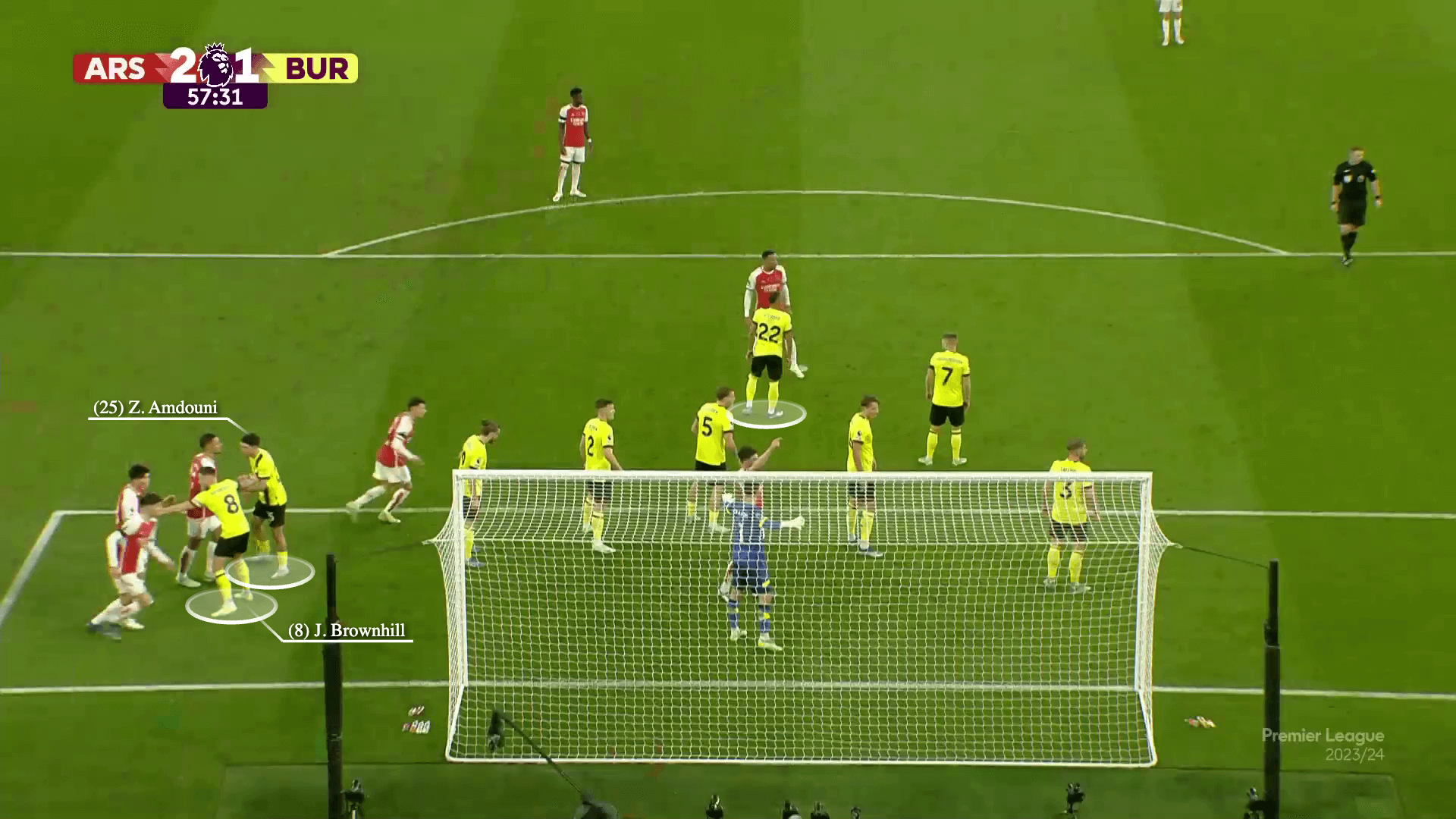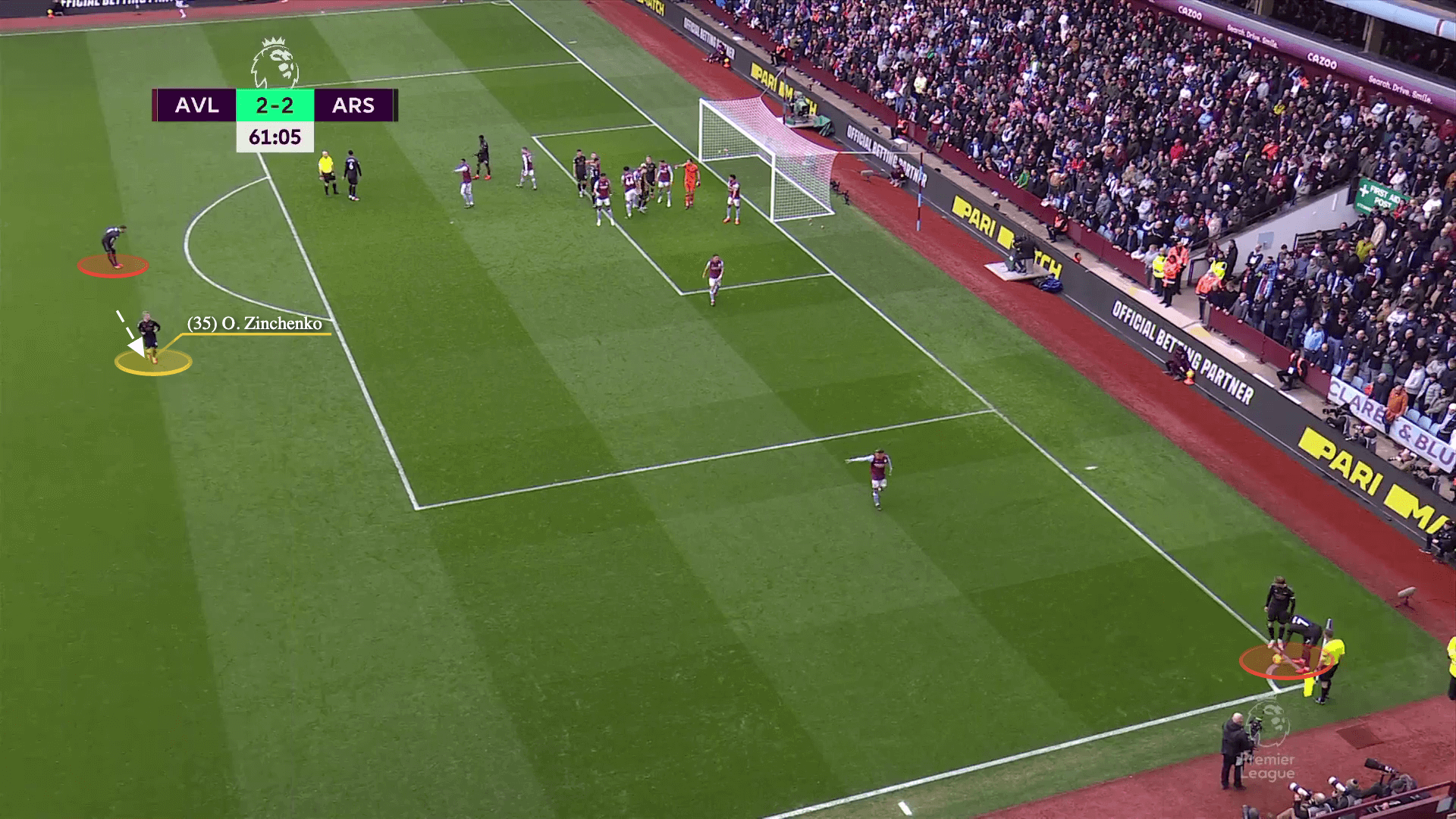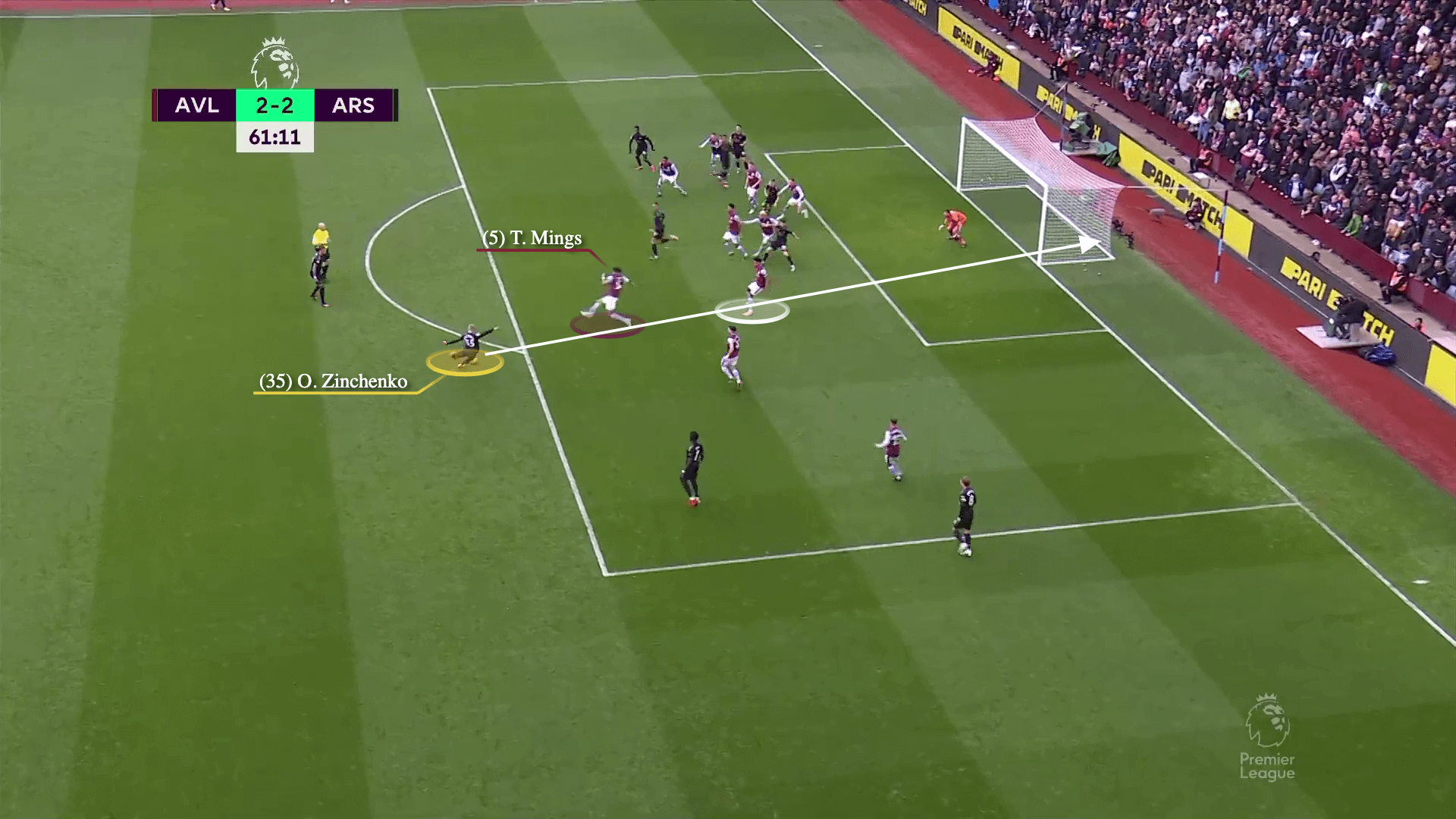In the Premier League’s recent set-piece boom, there have been two successful ways to approach corner kicks.
One is a base routine, where tweaks are modified according to the available players and the opponent’s defensive setup, such as Everton’s back-post corners under Sean Dyche.
The other, more complicated approach, is a variety of routines, which are chopped and changed from game to game — or even within the same match — to attack specific weaknesses in opponents and play to the strengths of the squad.
When thinking about the latter, Arsenal are the team that immediately comes to mind. Their diverse corners have been near impossible to plan for, and their relentless in-game modifications only makes the task harder.
The arrival of Nicolas Jover, Arsenal’s set-piece specialist, in the summer of 2021 has transformed the side’s attacking corners so positively that Mikel Arteta has been asked about Jover’s bonus in different press conferences. It remains a team effort though, because Arteta’s direction towards improving that area and the players’ studiousness and execution are also vital.

Since the 2021-22 Premier League season, Arsenal have been the most threatening team from attacking corners in the Premier League. When accounting for equal opportunity to deliver from a dead-ball situation, Arteta’s side have scored the most goals per 100 corners (6.1) and accumulated the highest expected goals (xG) per 100 corners (5.1).

In that period, Arsenal have constantly varied their corner routines and targeted different zones depending on each game’s requirements. But the common factor between their corners have been the principles which bind these routines.
Not all of the principles are present in each routine, but like the mother sauces in French cooking, they are the base on which all moves are built. “I dream of developing a recognisable style of set pieces, just like a playing style,” Jover told Christoph Biermann in his book, Football Hackers: The Science and Art of a Data Revolution.
The most obvious principles in Arsenal’s corner routines are:
- Orientation
- Disruption
- Misdirection
- Isolation
- Framing
Orientation is how the attackers position themselves to prevent the opponent from having both them and the ball in sight. Arsenal’s players do this by positioning themselves initially towards the back post and using the angles of their runs to stay in the blindside of their opponents.
Disruption is the process of blocking opponents and limiting the goalkeeper’s access to the ball, while using dummy runners to distract the defenders from the target zone is misdirection.

As for isolation, it’s about putting your most threatening players in one-versus-one situations away from the action or creating space for them to attack freely.
The final principle is framing — having multiple options across the width of the goal to increase the probability of scoring from different zones.
From attacking the near post by using blockers to isolating Gabriel at the back post, here are a few key examples of how Arsenal target different areas with different routines while sticking to those five key principles.
Near post
1. Gabriel vs West Ham United, November 2024
In this example, West Ham are defending with five man-markers, two to protect against the short option and shots near the penalty spot (claret) and three zonal defenders (white) across goal. Lucas Paqueta is protecting the near post, Max Kilman is in the central area and Tomas Soucek is positioned towards the back post.

Meanwhile, Arsenal have six players starting from the back post to maintain the orientation principle and make it harder for West Ham’s defenders to see them and the ball at the same time.
Kai Havertz, Riccardo Calafiori, William Saliba, Gabriel and Leandro Trossard are man-marked, while Jurrien Timber is left free.

As Bukayo Saka is preparing to take the corner, Timber and Trossard (red) dash towards the near post, Havertz (white) maintains his position, and Gabriel (yellow) uses Calafiori as a screen to separate himself from his marker, Michail Antonio.

The roles of Timber, Trossard, Saliba and Calafiori (red) are to disrupt West Ham’s defensive set up by preventing their goalkeeper and the two zonal defenders towards the near post from reaching the inswinging cross.
Saliba drags his marker in front of Lukasz Fabianski to pin the goalkeeper, Timber moves towards Paqueta (West Ham No 10) to interrupt his jump, and Trossard and Calafiori block Kilman (West Ham No 26) to trap the centre-back where he is.

By blocking Kilman and interrupting Paqueta’s jump, Arsenal create space for Gabriel (yellow) to attack towards the near post after the centre-back separates himself from Antonio. Behind him, Havertz (white) delays his run…

… to be in a position to attack the back post in case Gabriel only manages to flick the ball. However, the Brazil centre-back (yellow) heads it into the back of the net without needing Havertz (white) or Saliba (red), who are framing the goal.

2. Gabriel vs Newcastle United, February 2024
In Arsenal’s 4-1 home victory against Newcastle United last season, the visitors’ defensive setup was dismantled in a similar way — but this time by misdirecting the zonal players towards the near post instead of blocking them.
In this game Newcastle’s defensive setup consisted of Anthony Gordon defending the short corner, four zonal markers inside the six-yard area — two of which were protecting the near post — and five man-markers (white). Sean Longstaff is marking Saliba, Bruno Guimaraes is tracking Gabriel Martinelli near the penalty spot, and there’s a three-versus-three battle towards the back post between Sven Botman, Fabian Schar and Kieran Trippier from Newcastle’s side and Arsenal’s Havertz, Gabriel and Jakub Kiwior.

Initially, White’s role was to block Newcastle’s goalkeeper, Loris Karius, but that was tweaked after the first corner to further overload the near post.

Saka raising his right arm starts the routine with White (red) moving towards the near post, Kiwior (yellow) heading in the same direction, and Gabriel (yellow) arcing his run to get away from his man-marker with Havertz’s movement (yellow) acting as a screen.

White’s dash (red) towards the edge of the six-yard box moves Lewis Miley away from the near post, Kiwior (yellow) drags Trippier away from that zone as well, while Saliba (red) pins Longstaff to allow Gabriel (yellow) to attack the cross freely. By the penalty spot, Martinelli (white) moves towards the back post…

… to give Gabriel (yellow) another option when the centre-back connects with Saka’s cross. Gabriel chooses to head the ball towards the goal and, despite Karius’ save, Botman puts the ball into his own net.

Back post
1. Saliba vs Fulham, December 2024
In a much more recent example, Arsenal’s careful framing of the goal reaped its rewards when Havertz’s header was tapped in by Saliba in the 1-1 draw against Fulham last Sunday.
Here, Fulham are defending with one man-marker in Adama Traore (red), Sasa Lukic (Fulham No 20) protecting against the short corner, and the rest of the players are zonal: four towards the near post, Calvin Bassey and Issa Diop (white) in the central area, and Raul Jimenez and Emile Smith Rowe (yellow) towards the back post.

Arsenal’s setup is familiar, with Saka and Martin Odegaard by the edge of the penalty box, Jorginho (out of shot) behind them, Saliba (yellow) inside the six-yard area, and five players initially positioned at the back post.

As Declan Rice starts his run, Thomas Partey, Kiwior and Timber (red) move forward, but Havertz and Trossard (yellow) don’t follow and adjust their positions towards the back post. Trossard takes a couple of steps to the right, and Havertz drops to create space to make a run.

The idea behind this routine is to use Partey, Kiwior and Timber (red) to block Fulham’s zonal players towards the back post and vacate that space for an isolated Havertz (yellow) to attack, with Trossard (yellow) providing a second option in case the cross is overhit.
Meanwhile, Saliba’s central position disrupts Bernd Leno and puts the centre-back in a dangerous position if the header is played across the goal.

And this is precisely what happens when Havertz (yellow) heads the ball towards Saliba, and the centre-back scores the equaliser because of his role in framing the goal.

2. Martinelli vs Crystal Palace, August 2022
In an older example, Arsenal bamboozle Palace’s defenders on the opening weekend of the 2022-23 season by misdirecting them and using one of the players outside of the penalty area — whose main task was to defend against counter-attacks — as an offensive weapon.
Palace’s defensive setup was a mix of zonal and man-marking with four man-markers (blue), four zonal markers in the six-yard area and Eberechi Eze (also blue) towards the edge of the box to defend the short corner.
Here, Arsenal’s setup has two runners in Granit Xhaka and Gabriel, near the penalty spot, Gabriel Jesus by the byline, and three players outside the box in case they lose the ball when it’s crossed in.

The main player here is Oleksandr Zinchenko. Palace aren’t marking him because his initial position indicates that he is mainly there to defend the counter. This allows the left-back a free run at goal.
Gabriel fakes a move towards the near post, and Jesus’ positioning drags one Palace player out to a dead zone. As for the trio of Arsenal players in the six-yard area and Xhaka, their movements complement the rest of the routine. The three near the goal maintain their positions as the corner is played in…

… and Xhaka drops deeper, outside of the box, to replace Zinchenko (yellow) and make sure Arsenal have three players (White is out of shot) covering in case they lose the ball.

All of this creates the space for Zinchenko (yellow) to nod the ball into the six-yard box, where Arsenal have three players in position for a header at goal. Martinelli (white) meets Zinchenko’s headed pass and scores thanks to Arsenal — as usual — framing the mouth of the goal.

3. Gabriel vs Manchester City, September 2024
The isolation of Gabriel towards the back post has been a notable feature of Arsenal’s corners in the Jover era, especially after increasing their delivery towards that area this season. The second goal in the 2-2 draw away to Manchester City is an example of this approach’s effectiveness.
In this example, City’s defensive setup is zone-oriented, with Savinho defending the short corner, Kyle Walker (white) man-marking Gabriel, and eight zonal defenders around the six-yard box. Four of these are positioned at the near post, with Ruben Dias and Manuel Akanji central, and Bernardo Silva and Josko Gvardiol at the back post.

Arsenal have five players at the back post and Gabriel (yellow) up against Walker out by the penalty spot.

Partey and Calafiori (red) make runs to block Dias and Gvardiol. Simultaneously, Martinelli and Saliba (red) get close to Ederson and prevent him from dealing with the cross.
Havertz (yellow) holds his position, waiting to make a late run, while Gabriel (yellow) feints past Walker to attack the back post, which is where Saka is directing the corner.


By blocking Ederson, Dias and Gvardiol, Arsenal isolate Havertz (yellow) in a one-versus-one against Bernardo as a second option with a clear height mismatch. The main target, though, is Gabriel (yellow), who only has to beat Walker to attack the vacated zone, before heading the ball into the net.

Central
1. Gabriel vs Tottenham Hotspur, September 2024
One week before that goal against City, Gabriel jumped above Tottenham’s defence to meet another inswinging cross from Saka. But on that occasion, the centre-back was attacking the central space rather than the back post.
Tottenham’s defensive setup consisted of five man-markers (white), four zonal defenders across the mouth of the goal, and Son Heung-min (yellow) protecting against the short option.

Meanwhile, Arsenal attacked this corner with Gabriel (yellow) starting near the penalty spot, White and Saliba (red) inside the six-yard area, and Martinelli, Partey and Havertz (white) around it.

Saka’s signal starts the routine, and Havertz (white) immediately makes a dummy run towards the near post to drag Brennan Johnson away and misdirect Tottenham. Martinelli (red) dashes forward as well, but for a different purpose.

Martinelli’s task is to block Dominic Solanke (No 19), who is one of Tottenham’s zonal defenders protecting the central area, as Saliba and White (red) drag their markers in front of Guglielmo Vicario to disrupt the goalkeeper and prevent him from reaching the ball.
This creates space for Gabriel (yellow) to attack in the central zone of the six-yard box…

… and the centre-back, unopposed, meets Saka’s cross to head the ball past Vicario, with Partey (yellow) providing a second option behind him.

2. Saliba vs Burnley, November 2023
In another example of attacking the central space, Arsenal use a different routine to score against Burnley’s zone-oriented setup.
Here, Burnley are defending with six zonal players across the mouth of the goal, Luca Koleosho (out of shot) protecting against the short option, and three man-markers (white) in Vitinho, Zeki Amdouni and Josh Brownhill.

Arsenal have Takehiro Tomiyasu and Saliba (yellow) at the back post, Martinelli and Havertz moving towards the near one, Gabriel near the penalty spot and Rice (white) in front of the goalkeeper.

As Trossard takes the corner, Martinelli and Rice (white) make dummy runs towards the near post to misdirect Sander Berge and Charlie Taylor (claret) — who are the Burnley players defending that area — and move them out of position.
Behind them, Havertz (red) is looking to attack that space, while Saliba (yellow) moves in the same direction and Tomiyasu makes a late movement to get away from his marker.

Havertz (red) prevents Berge from dropping deeper as the inswinging corner travels beyond the near post, Saliba (yellow) positions himself in front of the goalkeeper to prevent him from reaching the cross, and Tomiyasu (yellow) changes direction to attack the back post.
The positioning of Havertz, Saliba and Tomiyasu means that Arsenal are framing the goal perfectly by covering all the zones…

… and Saliba duly beats James Trafford to the ball to put Arsenal into the lead.

Short
1. Zinchenko vs Aston Villa, February 2023
Arsenal are one of the best teams at using players deployed outside the opposition penalty area at attacking corners.
In this example, Odegaard and Saka are ready to take the short corner, with two players outside the penalty area in Zinchenko (yellow) and White (red). This leaves Arsenal with six players inside the Villa box…

… man-marked by an equal number of opponents. The remaining Villa players have different roles. Tyrone Mings is there to zonally defend the six-yard area, Philippe Coutinho’s task is to disrupt the short corner option, while Ollie Watkins and Alex Moreno (white) are defending the near post.

As the corner is played short, Zinchenko (yellow) takes small steps towards the ball, and because Coutinho (claret) is in a two-versus-one situation against Odegaard and Saka, Moreno (white, No 15) pushes out to support him.
The problem for Villa here is that none of their players have the capacity to move out towards Zinchenko: Moreno can’t leave Coutinho stranded against two Arsenal players, Mings is their best header — and the only free defender — in case a cross comes in, Watkins (white) is protecting the near post and the rest are man-marking.

This allows Odegaard to play the ball towards Zinchenko’s left foot…

… and the Ukrainian strikes it into the bottom corner with Mings and Watkins (white) late to react — largely because it is not their main job in the situation they were facing.

Another thing to note is the starting positions of Gabriel and Eddie Nketiah. They are both towards the far post, which indicates that Arsenal might be playing an inswinger with them acting as runners, and this also creates more space for Zinchenko towards the near side.

By learning the routines, opponents might think they can stop Arsenal’s corners. But if the task was that simple, Arsenal wouldn’t be the best set-piece team in the world. It’s the principles that underpin their dead-ball schemes that continue to make Mikel Arteta’s side so dangerous.
(Header design: Eamonn Dalton; Photo: Getty Images)





